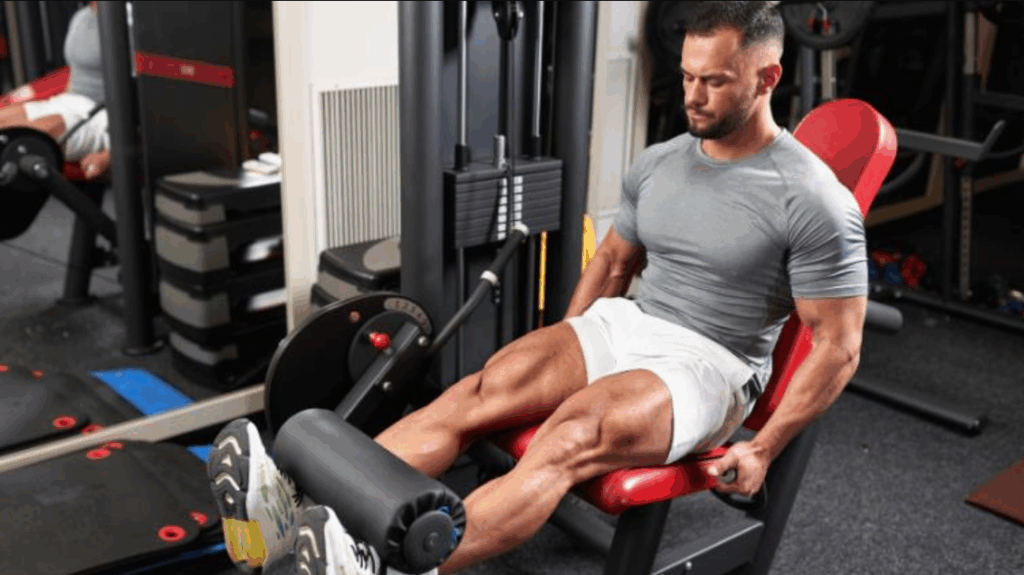For ACL recovery, experts recommend five key exercises: controlled leg extensions to rebuild early stability, single-leg balance training to improve proprioception, glute bridge progressions for posterior chain strength, mini-band walking exercises to enhance hip stabilization, and modified plyometrics for return-to-sport preparation. You’ll need to adapt each exercise to your recovery phase, focusing on proper form rather than intensity.
Discover how these targeted movements can accelerate your rehabilitation journey while preventing re-injury.
Controlled Leg Extensions for Early Stability
Restoring leg extension is critical during the initial phase of ACL recovery. You’ll want to begin with gentle, controlled movements that gradually increase your knee’s range of motion without placing stress on the healing ligament.
Start by sitting with your leg extended on a flat surface. Place a small rolled towel under your ankle and gently press your knee downward toward the surface. This simple exercise activates your quadriceps while maintaining proper alignment. As you progress, your physical therapist’s guidance will help you advance to slight leg lifts while keeping your knee straight.
Remember that post-surgery rehab should never cause sharp pain. Focus on quality over quantity, performing these extensions with precision rather than rushing through repetitions. Proper quadriceps strengthening now builds the foundation for more advanced exercises later.

Single-Leg Balance Training for Proprioception
After your knee has regained basic strength and mobility, single-leg balance training becomes essential for rebuilding your body’s position awareness. Proprioception often diminishes following ACL injuries, making you vulnerable to re-injury.
Start with basic single-leg stands on a firm surface for 30 seconds, focusing on maintaining proper knee alignment. Progress to more challenging variations by closing your eyes, standing on unstable surfaces like foam pads, or adding small movements while balanced. These rehabilitation exercises greatly improve knee stability by strengthening the small muscles that support your joint.
For ideal injury prevention, practice these exercises 3-4 times weekly, gradually increasing difficulty as your confidence grows. Your physical therapist can customize progressions based on your specific recovery timeline.

Glute Bridge Progressions for Posterior Chain Strength
Strengthening the posterior chain represents a cornerstone of successful ACL rehabilitation that complements the balance work you’ve been practicing. Your glutes and hamstrings provide essential support to your healing knee during functional mobility tasks.
Begin with basic glute bridges, lying on your back with knees bent and feet flat. Squeeze your glutes to lift your hips, focusing on hamstring activation without arching your lower back. As your ACL recovery advances, introduce progressive loading with single-leg variations, resistance bands around your knees, or elevating your feet on a stability ball. Your physical therapy program should gradually increase difficulty as pain decreases.

Mini-Band Walking Exercises for Hip Stabilization
Hip stabilizers are very important for your ACL recovery because they help keep your knees in the right position while you move and stop your knee from moving sideways, which can put stress on your healing ligament. Mini-band exercises are a great way to work these muscles because they use progressive resistance and are low-impact.
Put a resistance band just above your knees and take small, controlled steps to the side while keeping the band tight. Start with 10 steps in each direction, and pay more attention to how you do them than how fast you do them. Try monster walks (forward and backward steps with the band) as part of your balance training routine. They will work on different angles of your hip stabilizers.
These exercises promote muscle reactivation in your gluteus medius and minimus while maintaining the strength and flexibility balance needed for ideal knee function. Increase band resistance gradually as your stability improves.
Modified Plyometrics for Return-to-Sport Preparation
Properly progressed plyometric exercises represent a key milestone in late-stage ACL rehabilitation. These controlled jumping activities typically begin 4-6 months into your recovery timeline, once you’ve demonstrated adequate strength and stability in your knee.
Start with basic two-legged movements like small box jumps, progressing gradually to single-leg hops. Your focus should remain on proper landing mechanics. Soft landings with knees aligned over toes. Quality always trumps quantity during this phase.
Return-to-sport training requires these plyometric foundations before advancing to sport-specific drills. Work with your physical therapist to customize a program that mimics the demands of your activity while respecting your knee’s healing process. Remember that rushing this phase greatly increases re-injury risk, so patience with proper progression remains essential.
Frequently Asked Questions
Is Pool Therapy Effective During ACL Rehabilitation?
Yes, pool therapy is effective during ACL rehabilitation. You’ll benefit from water’s buoyancy, reducing joint stress while allowing movement. It’s especially helpful in early recovery when you can’t bear full weight.
How Does Weight Management Impact ACL Recovery?
Maintaining a healthy weight reduces stress on your healing ACL. You’ll experience less joint pain, faster rehabilitation progress, and decreased risk of complications.
Can Knee Braces Speed up ACL Healing?
Knee braces don’t actually speed up ACL healing, but they can provide stability and protection during your recovery. They’ll help control movement, reduce strain on your healing ligament, and potentially boost your confidence.
Should I Avoid Stairs Completely During Early Recovery?
No, you don’t need to avoid stairs completely. Take them slowly with support, using handrails and leading with your uninjured leg going up and your injured leg going down during early recovery.
What Sleeping Positions Are Best After ACL Surgery?
Sleep on your back with your leg elevated on pillows. You can also lie on your non-surgical side with pillows between your knees. Avoid sleeping on your stomach or surgical side.





